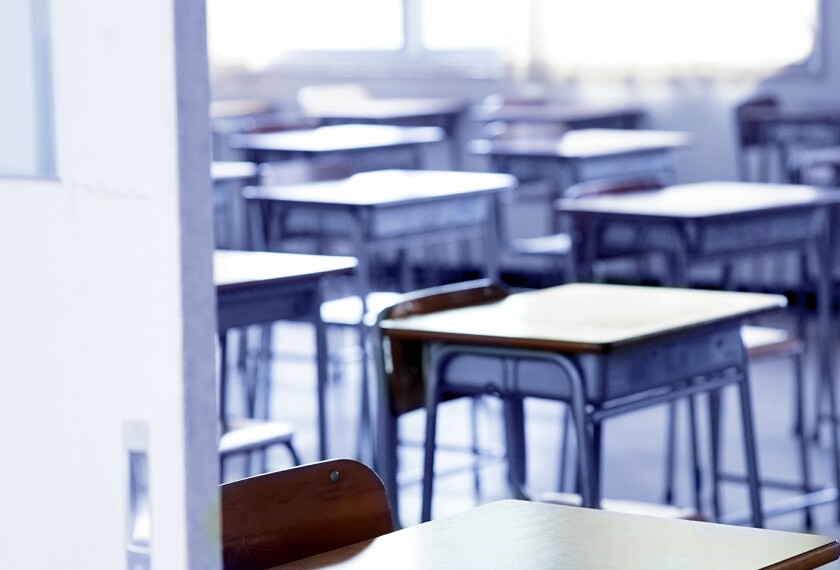As school districts deal with enrollment declines and the end of pandemic-era relief funds that padded their budgets for three years, more are facing one of the most controversial and impassioned decisions in K-12 education: whether to close buildings with lower enrollments.
Districts large and small, from California to New York, are considering closures as they confront enrollment drops that have accelerated in recent years.
And there’s no sign of the trend reversing, according to David DeSchryver, the senior vice president and co-director of research at Whiteboard Advisors, a communications, research, and consulting firm.
For many districts, enrollment declines aren’t what’s surprising—projections dating as far back as 2012 showed birth rates stalling, with the decline often most pronounced in urban districts, presaging smaller student populations in the years to come, DeSchryver said.
The surprise is just how quickly those declines have come about in the last few years.
Suddenly, lower birth rates combined with some families opting out of public education and pandemic-era population shifts propelled by more people leaving urban areas for more suburban and rural settings.
To top it off, pandemic-era relief funds are set to expire later this year, putting more stress on districts’ budgets.
Those factors have merged to create the “perfect storm” for many districts’ enrollments and budgets, leading more to put school building closures on the table, DeSchryver said.
“The rate of decline was probably thought to be addressable and manageable, and then the pandemic came around, and suddenly that rate really accelerated,” DeSchryver said. “Now what used to be something that could be addressed over time has a level of urgency to it that needs to be addressed now, and we expect that trend to grow.”
Indeed, debates about potential school closures are picking up in communities across the country.
In Boston, district leaders unveiled a long-term facilities plan this month that detailed that as many as half the city’s public schools could close in the coming years. The district’s enrollment has dropped more than 14 percent in the past decade, from 56,000-plus in 2014 to fewer than 49,000 this school year, according to The Boston Globe. However, the district doesn’t have specific school closure proposals pending, and the long-range facilities plan doesn’t include a timeline.
Elsewhere, the Edgewood Independent district in Texas recently voted to close two schools at the end of this school year, joined by two elementary schools in Alpine, Utah, and two elementary schools in Flint, Mich., set to close in the next two years.
The history of school closures is inequitable
Some recent research suggests that between 2000 and 2018, schools with majority-Black student bodies were about three times as likely to close as schools with smaller proportions of Black students, even when accounting for common reasons behind closures.
The study’s findings add to growing research suggesting school closures are often inequitable and can disproportionately affect already disadvantaged students.
So, it’s important that districts consider the impacts of school closures beyond a line in the budget, DeSchryver said.
“It’s a complex and difficult challenge, regardless of the decisions made, but there’s no question that historically, closures fall hardest upon poor communities and communities of color,” he said. “So, districts really need to be thinking about who gets the stability and who doesn’t and why.”
In Rochester, N.Y., where district leaders in October voted to close 11 of the city’s 45 schools in a belt-tightening move, parents and advocates pushed back, saying the decisions would disproportionately hurt students in special education and English learners, according to local news reports.
Superintendent Carmine Peluso told local media that leaders will attempt to avoid splitting those students up by moving their entire classroom groups to the same schools.
“Our district has experienced a consistent decline in enrollment for more than a decade and must make the necessary adjustments to create better learning and extracurricular opportunities in modernized facilities with highly qualified staff and programming to meet the diverse interests of our students,” says the district’s website detailing the plan.
Similarly, district leaders in San Antonio, Texas, voted in November to close 15 schools after several years of declining enrollment, from more than 52,000 in 2016 to about 45,000 in the 2022-23 school year. Some community members pushed back, citing an audit that found a prior round of school closures in 2015 didn’t lead to better attendance, grades, or state test results for students.
While closing buildings is a difficult decision that can pose challenges for staff and families alike, researchers argue putting it off too long can be equally difficult on districts that are then stretched too thin trying to staff and maintain buildings that their budgets, often funded on a per-pupil basis, cannot support.
School closure proposals are unlikely to abate in the short term
For every district that has recently made the decision to shutter campuses, even more are considering the move.
DeSchryver recommended that those districts notify their communities as early as possible that closures could be coming.
“These decisions have implications for everything from the real estate market to where parents choose to live—whether they buy a house or stay in an apartment,” DeSchryver said. “There certainly needs to be some awareness and some notice for what’s being planned.”
From there, district leaders would be best served by “engaging the community in difficult but necessary conversations” about potential closures, being transparent about the options they’re considering and why, and the likely path forward for displaced students, DeSchryver said.
“The more due diligence you do in listening and taking in that feedback and incorporating it into iterations of future plans, the less shock or surprise there will be,” he said. “Even if people are upset about the decisions—and there always will be people who are—there’s a clear and defensible record that in light of all of the facts and conversations, this was the most beneficial option for the community, school, and students.”









